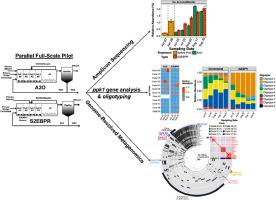Water Research ( IF 11.4 ) Pub Date : 2021-09-30 , DOI: 10.1016/j.watres.2021.117725 Varun N Srinivasan 1 , Guangyu Li 2 , Dongqi Wang 3 , Nicholas B Tooker 4 , Zihan Dai 5 , Annalisa Onnis-Hayden 2 , Charles Bott 6 , Paul Dombrowski 7 , Peter Schauer 8 , Ameet Pinto 9 , April Z Gu 10

|
Candidatus Accumulibacter phosphatis (CAP) and its clade-level micro-diversity has been associated with and implicated in functional differences in phosphorus removal performance in enhanced biological phosphorus removal (EBPR) systems. Side-stream EBPR (S2EBPR) is an emerging process that has been shown to present a suite of advantages over the conventional EBPR design, however, large knowledge gaps remain in terms of its underlying ecological mechanisms. Here, we compared and revealed the higher-resolution differences in microbial ecology of CAP between a full-scale side-stream EBPR configuration and a conventional A2O EBPR process that were operated in parallel and with the same influent feed. Even though the relative abundance of CAP, revealed by 16S rRNA gene amplicon sequencing, was similar in both treatment trains, a clade-level analysis, using combined 16S rRNA-gene based amplicon sequencing and oligotyping analysis and metagenomics analysis, revealed the distinct CAP microdiversity between the S2EBPR and A2O configurations that likely attributed to the improved performance in S2EBPR in comparison to conventional EBPR. Furthermore, genome-resolved metagenomics enabled extraction of three metagenome-assembled genomes (MAGs) belonging to CAP clades IIB (RCAB4-2), IIC (RC14) and II (RC18), from full-scale EBPR sludge for the first time, including a distinct Ca. Accumulibacter clade that is dominant and associated only with the S2EBPR configuration. The results also revealed the temporally increasing predominance of RC14, which belonged to Clade IIC, during the implementation of the S2EBPR configuration. Finally, we also show the existence of previously uncharacterized diversity of clades of CAP, namely the clades IIB and as yet unidentified clade of type II, in full-scale EBPR communities, highlighting the unknown diversity of CAP communities in full-scale EBPR systems.
中文翻译:

寡分型和宏基因组学揭示了侧流中不同的 Candidatus Accumulibacter 群落与传统的全面增强型生物除磷 (EBPR) 系统
候选人Accumulibacter phosphatis (CAP) 及其进化枝级别的微多样性与增强型生物除磷 (EBPR) 系统中除磷性能的功能差异相关联。侧流 EBPR (S2EBPR) 是一种新兴工艺,已被证明与传统 EBPR 设计相比具有一系列优势,但是,在其潜在生态机制方面仍然存在巨大的知识差距。在这里,我们比较并揭示了全尺寸侧流 EBPR 配置与并行操作并使用相同进水进料的常规 A2O EBPR 工艺之间 CAP 微生物生态学的更高分辨率差异。尽管 16S rRNA 基因扩增子测序揭示的 CAP 的相对丰度在两种治疗序列中相似,进化枝水平分析,使用组合的基于 16S rRNA 基因的扩增子测序和寡分型分析以及宏基因组学分析,揭示了 S2EBPR 和 A2O 配置之间明显的 CAP 微多样性,这可能归因于与传统 EBPR 相比,S2EBPR 的性能提高。此外,基因组解析的宏基因组学首次能够从全尺寸 EBPR 污泥中提取属于 CAP 进化枝 IIB (RCAB4-2)、IIC (RC14) 和 II (RC18) 的三个宏基因组组装基因组 (MAG),包括一个独特的大约 Accumulibacter 进化枝占主导地位,仅与 S2EBPR 配置相关。结果还揭示了在 S2EBPR 配置的实施过程中,属于 Clade IIC 的 RC14 在时间上的优势。最后,我们还展示了先前未表征的 CAP 进化枝多样性的存在,即进化枝 IIB 和尚未鉴定的 II 型进化枝,在全尺度 EBPR 社区中,突出了全尺度 EBPR 系统中 CAP 社区的未知多样性。











































 京公网安备 11010802027423号
京公网安备 11010802027423号